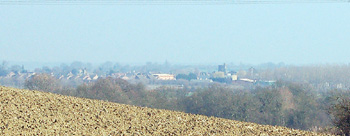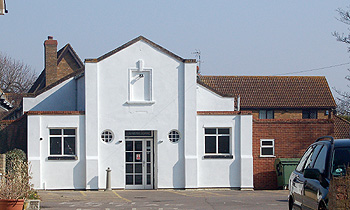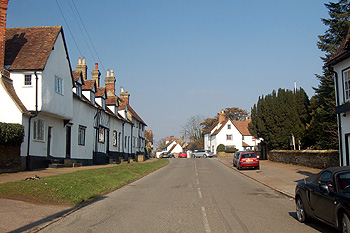The Parish of Silsoe in General

View towards Silsoe from Hillfoot Farm March 2011
Landscape
Volume II of The Victoria County History for Bedfordshire, published in 1908 gives the area of Silsoe as 2,157 ½ acres. Of this 12 acres were covered by water (the artificial water features in Wrest Park), 691 acres were arable and 1,266¾ pasture.
The lowest point in the parish as at 173 feet above sea level, surrounding the site of the old mansion of Wrest Park. The highest point, at 259 feet is around Newbury Farm moat. The church is about 220 feet above sea-level, the current mansion of Wrest Park is about 200 feet and the Banqueting House about 190 feet above sea-level.
Most of the solid, or underlying, geology is greensand; the sandstone is called Woburn Sands Formation and was laid down in warm, shallow Cretaceous Period seas between 99 and 121 million years ago. A narrow band of Gault Formation, a mudstone laid down about the same time, runs from Wrest Park to the north-south plantation between West End Road and Silsoe Road and another area of the material lies in a U-shape borth of the village and including parts of Newbury Lane and Newbury Farm. This area of gault clay has a mixture of sand, gravel, clay and silt above it known as head.

Silsoe sign March 2011
Name
The name Silsoe includes the Anglo-Saxon word "hoh" meaning a hill with a personal name and means Sifel's hill. The following forms have appeared over the years:
- Siuuilessou: 1086;
- Sewilessou: 1086;
- Siuelisho: 1175;
- Siuelesho: 1199-1330;
- Syuelesho: 1199-1330;
- Shiuelsho: 1242-1316;
- Shiuelshou: 1242-1316;
- Siuelho: 1276;
- Syuelso: 1323;
- Sevelesho: 1419;
- Sybylso: 1479-1485;
- Silshoo: 1506;
- Sylsoo: 1535.

The Hall March 2011
Administrative History
Silsoe was a hamlet with its own chapel of ease in the ancient parish of Flitton. It became a separate ecclesiastical parish in 1846 and twenty years later a separate civil parish too.
The modern civil parish is bordered by Clophill to the north, by Gravenhurst to the east, by Shillington to the south-east, by Barton-le-Clay to the south, by Pulloxhill to the south-west, by Flitton to the west and by Maulden to the north-west.

High Street Silsoe, the former A6, March 2011
Population
The Domesday Book of 1086 records 24 people in Silsoe. These are just the heads of households and so the figure must be multiplied by a factor of at least four, suggesting around a hundred people, making it a good sized settlement for the time.
The population of Silsoe shown below is taken from census records. The number of people living in the village virtually doubled between 1961 and 1971 as many new houses were built and, given the large amount of construction taking place at the time of writing [2011] the population looks set greatly to increase once again.
- 1801: 447;
- 1811: 480;
- 1821: 568;
- 1831: 726;
- 1841: 788;
- 1851: 755;
- 1861: 713;
- 1871: 718;
- 1881: 679;
- 1891: 589;
- 1901: 528;
- 1911: 561;
- 1921: 585;
- 1931: 588;
- 1951: 726;
- 1961: 672;
- 1971: 1,273;
- 1981: 1,199;
- 1991: 1,559;
- 2001: 1,729;
- 2011: 1,791.